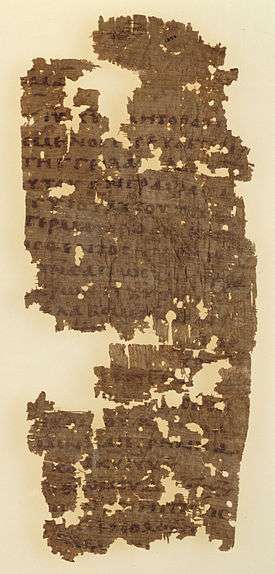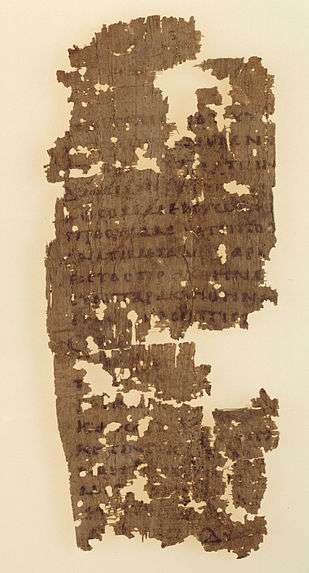Romans 1
Romans 1 is the first chapter of the Epistle to the Romans in the New Testament of the Christian Bible. It is authored by Paul the Apostle, while he was in Corinth in the mid 50s AD,[1] with the help of an amanuensis (secretary), Tertius, who adds his own greeting in Romans 16:22.[2] Acts 20:3 records that Paul stayed in Greece, probably Corinth, for three months.
| Romans 1 | |
|---|---|
← Acts 28 | |
.jpg) Epistle to the Romans 1:1–7 in Papyrus 10, written about AD 316. | |
| Book | Epistle to the Romans |
| Category | Pauline epistles |
| Christian Bible part | New Testament |
| Order in the Christian part | 6 |

Attention has been given to Romans 1:26-27 and the biblical viewpoint on homosexual intercourse.[3] The historically dominant viewpoint is that this verse is a blanket condemnation of both male and female homosexual activity,[4] although this has been increasingly challenged in recent years.[5] As of 2011, the traditional viewpoint remains the majority opinion in critical scholarship.[3]
Text
The original text was written in Koine Greek. This chapter is divided into 32 verses.
Textual witnesses
Some early manuscripts containing the text of this chapter in Koine Greek are:[6]
- Papyrus 40 (~250; extant verses 24–27, 31–32)
- Papyrus 10 (AD 316; extant verses 1–7)[7]
- Codex Vaticanus (325–350)
- Codex Sinaiticus (330–360)
- Codex Alexandrinus (400–440)
- Codex Ephraemi Rescriptus (~450; extant verses 4–32)
A later manuscript, Codex Boernerianus (probably ninth century) does not use the phrase ἐν Ῥώμῃ (in Rome). In verse 7 this phrase was replaced by ἐν ἀγαπῃ (in love, Latin interlinear text – in caritate et dilectione), and in verse 15 the phrase is omitted from both the Greek and Latin texts.[8]
Old Testament references
- Romans 1:17 = Habakkuk 2:4
New Testament references
- Romans 1:17 = Galatians 3:11, and Hebrews 10:38
Prescript (1:1–7)
The letter is addressed "to all in Rome who are loved by God and called to be saints" [9] but not to "the church in Rome" as such. Methodist founder John Wesley suggested that the believers in Rome "were scattered up and down in that large city, and not yet reduced into the form of a church".[10]
Thanksgiving and occasion (1:8–15)
As with many of the Pauline epistles, Paul's first thoughts are of thanksgiving for the widespread reputation of the faith of the Roman Christians (verse 8), then he expresses his longing to visit and minister to Rome.[11]
Verse 8
- First, I thank my God through Jesus Christ for you all, that your faith is spoken of throughout the whole world[12]
Paul's thanksgivings in his epistles[lower-alpha 1] usually signal important themes in those letters, such as in this verse, he states his obligation to proclaim the gospel to the Romans 'as priestly service' (verse 9, cf. Romans 15:16,25).[13]
The theme of the epistle (1:16–17)
Here Paul gives his description of the "gospel", which becomes the central theme (the keyword and the central motif) of the epistle, as well as a transition between the letter opening (1:1–15) and the body (1:18–15:13).[11]
Verse 16
- For I am not ashamed of the gospel; it is the power of God for salvation to everyone who has faith, to the Jew first and also to the Greek.[14]
Verse 17
- For therein is the righteousness of God revealed from faith to faith: as it is written, The just shall live by faith.[15]
Citation from Habakkuk 2:4
- "The just shall live by faith" (ὁ δὲ δίκαιος ἐκ πίστεως ζήσεται).[16]
The Septuagint of Habakkuk 2:4 has ὁ δὲ δίκαιος ἐκ πίστεώς μου ζήσεται.[17]
The phrase comprising the last three Hebrew words of Habakkuk 2:4 (וצדיק באמונתו יחיה)[18] is cited in Greek three times in the New Testament, all in Pauline epistles — Romans 1:17; Galatians 3:11; and Hebrews 10:38 — "demonstrating its importance to the early church," asserted Dockery.[19]
Moody Smith, Jr. showed that in this verse, by exegesis of Galatians 3:11 (also quoting Habakkuk 2:4), Paul took the ek pisteos with the verb zesetai not by the subject of the sentence, ho dikaios.[20] This is supported by Qumran interpretation of the text, as well as Paul's contemporaries and more recent commentators, such as Lightfoot.[21]
God's wrath on the Gentiles (1:18–32)
The first two verses (18–19) function as the "heading" for the exposition that runs to {{bibleverse|Romans|3:20), that God's wrath falls on all human beings who turn from God and do not follow the truth of God; a consistent picture of a just God who acts to judge sin in both the Old Testament and New Testament.[22] Paul starts first with God's wrath that comes deservedly on the Gentiles (20–32), drawn against the background of the fall of the first human beings in to sin.[22]
Several scholars believe verses 18 to 32 (and chapter 2) are a non-Pauline interpolation, but this is a minority position.[23]
Verses 19–20
- For what can be known about God is plain to them, because God has shown it to them. Ever since the creation of the world his eternal power and divine nature, invisible though they are, have been understood and seen through the things he has made. So they are without excuse.[24]
In verses 19-20, Paul writes about the 'knowledge of God'. This passage gives one of the important statements in the Bible relating to the concept of 'natural revelation': that other than revealing Himself in Christ and in the Scriptures, God reveals Himself to everyone through nature and history, and all human beings have the capacity to receive such revelation because they continue to bear the divine image.[22] It echoes what Paul and Barnabas has said to a crowd in Lystra in Acts 14:16-17:
- The living God ... made the heaven, the earth, the sea, and all things that are in them, who in bygone generations allowed all nations to walk in their own ways. Nevertheless He did not leave Himself without witness, in that He did good, gave us rain from heaven and fruitful seasons, filling our hearts with food and gladness.[25]
The Gospel (Romans 1:20-25)
Paul begins to explain from verse 18 onwards why the "gospel" (Greek: το ευαγγελιον του χριστου, to evangeliou tou Christou) is needed: it is to save humankind, both gentiles and Jews, from the wrath of God (Greek: οργη θεου). The wrath of God is explained by Lutheran theologian Heinrich Meyer as "the affection of a personal God, ... the love of the holy God (who is neither neutral nor one-sided in His affection) for all that is good in its energy as antagonistic to all that is evil".[26]
Verses 26–27
For this cause God gave them up unto vile affections: for even their women did change the natural use into that which is against nature: And likewise also the men, leaving the natural use of the woman, burned in their lust one toward another; men with men working that which is unseemly, and receiving in themselves that recompense of their error which was meet.[27]
- "gave them up" (also in verse 24; "gave them over" in verse 28) is from the Greek word paradidomi, "hand over", refers to more than a passive withholding of divine grace on God's part, but as God's reaction to the people who turning from the truth of God and his moral requirements, that is to "turn them over" their own gods and sinful ways as well as the consequences of it (verses 23, 25, 27).[28]
- "the due", "which was meet" (KJV) or "was fitting" (King James 2000 Bible) (Greek: ἔδει, edei). Equivalent to "was due" , which is better, though the word expresses a necessity in the nature of the case - that which must needs be as the consequence of violating the divine law.[29]
- "penalty" or "recompence" (KJV) (Greek: ἀντιμισθίαν, antimisthian)
Greek concordance and lexicon define this word as: "a reward, recompense, retribution";[30] "remunerating, a reward given in compensation, requital, recompense; in a bad sense."[31]
Interpretation
This passage has been debated by 20th and 21st-century interpreters as to its relevance today and as to what it actually prohibits.
Although Christians of several denominations have historically maintained that this verse is a complete prohibition of all forms of homosexual activity,[4] some scholars and theologians have argued that the passage is not a blanket condemnation of homosexual acts.[5] Additional controversy has arisen over the authentic text of the passage, and whether Romans 1:26-27 was a later addition to the text. (And thus not inspired)[23]
Blanket condemnation view
This perspective sees Romans 1:26-27 is a blanket condemnation of both male and female homosexual activity enduring to the present day.
Condemnation of unnatural heterosexual sex and gay sex view
This perspective sees Romans 1:26 is a blanket condemnation of unnatural heterosexual activity enduring to the present day, such as anal sex,[32] whereas Romans 1:27 is a blanket condemnation of male homosexual activity enduring to the present day.[33]
Interpolation view
A minority of scholars have suggested that Romans 1:26-27 is a non-Pauline interpolation. This position can be combined with any of the other perspectives listed in the article.[34]
Cultural view
Some have suggested that the condemnation was relative to Paul's own culture, in which homosexuality was not understood as an orientation and in which being penetrated was seen as shameful.[5]
Pagan ritual view
Others have suggested that it is a condemnation of pagan rituals.[5]
Experimental view
Others suggested that the passage condemned heterosexuals who experiment with homosexual activity.[5]
See also Epistle to the Romans#The judgment of God (1:18–32)
See also
Notes
References
- Hill 2007, p. 1084.
- Donaldson, Terence L. (2007). "63. Introduction to the Pauline Corpus". In Barton, John; Muddiman, John (eds.). The Oxford Bible Commentary (first (paperback) ed.). Oxford University Press. p. 1077. ISBN 978-0199277186.
- Kruse, Colin (2012). Paul Letter to the Romans. Wm. B. Eerdmans Publishing Co. p. 111.
- Hertzog, Mark (1996). The lavender vote: Lesbians, gay men, and bisexuals in American electoral politics. NYU Press. p. 58. ISBN 0-8147-3530-4.
- Kruse, Colin (2012). Paul Letter to the Romans. Wm. B. Eerdmans Publishing Co. p. 111.
- List of manuscripts „Fortsetzung der Liste der Handschriften“ Institut für Neutestamentliche Textforschung, Universität Münster. (PDF-file; 147 kB)
- Grenfell, B. P.; Hunt, A. S., Oxyrhynchus Papyri II (1899), pp. 8–9.
- Metzger, Bruce M.; Ehrman, Bart D. (2005). The Text of the New Testament: Its Transmission, Corruption and Restoration (4 ed.). New York – Oxford: Oxford University Press. pp. 75–76. ISBN 978-0-19-516122-9.
- Berean Study Bible, Romans 1:7
- Wesley's Notes on the Bible on Romans 1, accessed 1 September 2016
- Moo 1994, p. 1120.
- Romans 1:8 NKJV
- Coogan 2007, pp. 243–244.
- Romans 1:16 NRSV
- Romans 1:17 KJV
- Romans 1:17 in Greek. Biblehub.com
- Habakkuk 2 in Swete's Septuagint. Biblehub.com
- Habakkuk 2:4 in Hebrew. Biblehub.com
- Dockery, David S. “The Use of Hab. 2:4 in Rom. 1:17: Some Hermeneutical and Theological Considerations.” Wesleyan Theological Journal 22, no. 2 (September 1, 1987): 24–36.
- Smith, D. Moody, Jr. "HO DE DIKAIOS EK PISTEOS ZESETAI". Second article in XXIX (Studies & Documents, ed. Jacob Geerlings), Studies in the History and Text of the New Testament in honor of Kennet Willis Clark, Boyd L. Daniels & M. Jack Suggs, eds., pp. 13-25.
- Lightfoot wrote: "I cannot doubt that ek pisteos is to be taken with zesetai; and not with ho dikaios". Lightfoot, J.B. Notes on the Epistles of St. Paul, Bibliolife. 2010. p. 250. ISBN 978-1140434795.
- Moo 1994, p. 1122.
- Percy Neale Harrison, Paulines and Pastorals (London: Villiers Publications, 1964), 80–85; Robert Martyr Hawkins, The Recovery of the Historical Paul (Nashville, TN: Vanderbilt University Press, 1943), 79-86; Alfred Firmin Loisy, The Origins of the New Testament (New Hyde Park, NY: University Books, 1962), 250; ibid., The Birth of the Christian Religion (New Hyde Park, NY: University Books, 1962), 363 n.21; Winsome Munro, Authority in Paul and Peter: The Identification of a Pastoral Stratum in the Pauline Corpus and 1 Peter, SNTSMS 45 (Cambridge: Cambridge University Press, 1983), 113; John C. O'Neill, Paul's Letter to the Romans (Harmondsworth: Penguin Books, 1975), 40-56; William O. Walker, Jr., "Romans 1.18–2.29: A Non-Pauline Interpolation?" New Testament Studies 45, no. 4 (1999): 533–52.
- Romans 1:19-20 NRSV
- New King James Version
- Meyer's NT Commentary on Romans 1, accessed 4 September 2016
- Romans 1:26–27
- Moo 1994, pp. 1122–3.
- Vincent, Marvin R., Vincent's Word Studies in the New Testament, 1985.
- Strong, J. The exhaustive concordance of the Bible: Showing every word of the text of the common English version of the canonical books, and every occurrence of each word in regular order. Ontario: Woodside Bible Fellowship. 1996.
- Thayer, Joseph. Thayer's Greek-English Lexicon of the New Testament: Coded with Strong's Concordance Numbers. Peabody: Hendrickson Publishers. 1995. ISBN 9781565632097.
- Miller, James E. (January 1995). "The Practices of Romans 1:26: Homosexual or Heterosexual?". Novum Testamentum. 37 (Fasc. 1): 1–11. JSTOR 1561233.
- Murphy, David J. (2019). "More Evidence Pertaining to "Their Females" in Romans 1:26". Journal of Biblical Literature. 138 (1): 221–240. doi:10.15699/jbl.1381.2019.522595. JSTOR 10.15699/jbl.1381.2019.522595.
- Percy Neale Harrison, Paulines and Pastorals (London: Villiers Publications, 1964), 80–85; Robert Martyr Hawkins, The Recovery of the Historical Paul (Nashville, TN: Vanderbilt University Press, 1943), 79-86; Alfred Firmin Loisy, The Origins of the New Testament (New Hyde Park, NY: University Books, 1962), 250; ibid., The Birth of the Christian Religion (New Hyde Park, NY: University Books, 1962), 363 n.21; Winsome Munro, Authority in Paul and Peter: The Identification of a Pastoral Stratum in the Pauline Corpus and 1 Peter, SNTSMS 45 (Cambridge: Cambridge University Press, 1983), 113; John C. O'Neill, Paul's Letter to the Romans (Harmondsworth: Penguin Books, 1975), 40-56; William O. Walker, Jr., "Romans 1.18–2.29: A Non-Pauline Interpolation?" New Testament Studies 45, no. 4 (1999): 533–52.
Sources
- Coogan, Michael David (2007). Coogan, Michael David; Brettler, Marc Zvi; Newsom, Carol Ann; Perkins, Pheme (eds.). The New Oxford Annotated Bible with the Apocryphal/Deuterocanonical Books: New Revised Standard Version, Issue 48 (Augmented 3rd ed.). Oxford University Press. ISBN 9780195288810.
- Hill, Craig C. (2007). "64. Romans". In Barton, John; Muddiman, John (eds.). The Oxford Bible Commentary (first (paperback) ed.). Oxford University Press. pp. 1083–1108. ISBN 978-0199277186. Retrieved February 6, 2019.
- Moo, Douglas J. (1994). "Romans". In Carson, D. A.; France, R. T.; Motyer, J. A.; Wenham, G. J. (eds.). New Bible Commentary: 21st Century Edition (4, illustrated, reprint, revised ed.). Inter-Varsity Press. pp. 1115–1160. ISBN 9780851106489.
External links
- Romans 1 King James Bible - Wikisource
- English Translation with Parallel Latin Vulgate
- Online Bible at GospelHall.org (ESV, KJV, Darby, American Standard Version, Bible in Basic English)
- Multiple bible versions at Bible Gateway (NKJV, NIV, NRSV etc.)


